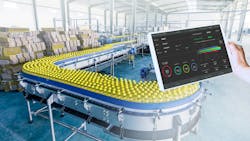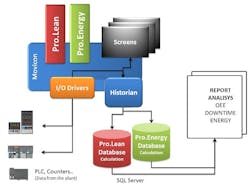Getting analytics in the hands of operators
We have all had the experience of knowing the general location of someplace where we want to go, but not quite knowing exactly the best way to get there. For example, getting to all those interesting restaurants downtown via the best route without too much traffic and any construction. One way to do this would require a lot of research, but the most obvious answer today is to use a mobile app that optimizes the route.
Data analytics for industrial automation systems can present a similar situation. OEM machine builders and operations personnel at end-user production plants know how their systems work, and often have a good sense of what they perceive to be the best ways to run things. Yet these users could benefit from some detailed, real-time and data-backed guidance showing them how to improve efficiency, remove bottlenecks and save energy.
While most companies employ great teams running day-to-day operations, it can be challenging for many of these organizations to support the right mix of specialized engineering and analytical personnel to support data-gathering, industrial internet of things (IIoT) and related analytics initiatives.
To address this and other issues, there are new industry-oriented software products available for helping OEMs and operations personnel apply their knowledge to data analytics projects, without needing to know all the intricacies of complex automation or programming systems.
Empowering users with information
Users of all types, whether they are the OEMs developing machinery or plant personnel using the equipment, want to access and analyze the wide variety of available machine operational and performance data. Human-machine interface (HMI) and supervisory control and data acquisition (SCADA) software provide visibility, but these types of applications are usually light on true analytics. Some companies are aware that a manufacturing execution system (MES) can perform analytics, but these systems are expensive to purchase, install, use and maintain. Many companies need a more lightweight and targeted answer (Figure 1).
OEMs can analyze data from in-service equipment to fine tune the engineering aspects of the machinery they supply, and to offer tailored support and other value-added services for their manufacturing customers. These OEMs also want to provide better solutions than their competition to give them an edge in the market.
Manufacturing end users need analyzed data from all their machinery to determine overall equipment effectiveness (OEE) and other key performance indicators (KPIs) so they can optimize the production rates, product quality, equipment availability, energy consumption and other factors. Analytical results give these end users better visibility into their operations, and near-real-time information helps them make timely decisions for best productivity.
OEMs and manufacturing end users employ knowledgeable personnel who are intimately familiar with the equipment and processes but may not have the technical skills or required tools needed to execute an analytics project. These types of projects need to interface with some type of industrial automation or facility instrumentation, but at many sites the issue is complicated because portions of the operation have little or no automation, or perhaps outdated systems.
Unlocking analytics for everyone
To help users of all types efficiently implement effective industrial analytics, a better way is needed than the traditional approach of engaging numerous specialists and creating custom code. The modern answer is to use analytics software platforms pre-engineered to work with industrial systems and arranged to walk users through the most common tasks using wizards and dialog-driven prompts. A practical software solution lets users apply their own expertise to quickly deploy analytics projects, without requiring a high level of IT expertise, large capital expenditures or a long deployment.
Here are some key features of software that makes analytics accessible for everyone:
- Wizards and dialog-driven prompts for reducing time to deployment (Figure 2).
- An open and cross-platform architecture, empowering users to deploy analytics on any new or existing system.
- Connectivity to all types of data sources, along with the flexibility to improve granularity and detail as the analytics are refined (Figure 3).
- Scalability for growth, with the ability for advanced users to customize configurations.
- Capable of being integrated with an HMI/SCADA platform, or operating independently in parallel with one, because HMI/SCADA systems provide a good basis of connectivity, database/historian, visualization and reporting elements (Figure 4).
With the right software, users can create and use analytics as needed for one machine, for a production line or for an entire plant.
Responsive results
One organization had an outdated and expiring OEE software application implemented throughout their plants. By using Movicon.NExT and Pro.Lean, the team was able to implement a proof of concept within a matter of days, and then deploy it to a few of their plants for evaluation. The results exceeded all expectations, and the end users especially appreciated the flexibility and customization options so they could tailor the implementation to their particular processes and visualization needs. A traditional approach would have taken months, and it would have introduced complications and risk.
In another case, the water usage at a large farm had become excessive and expensive. The farm operators needed to decide whether to invest capital and increase water treatment capacity, or whether they should try other options. To gain the required information, they quickly implemented Movicon.NExT and Pro.Energy, monitoring water flow meters at various usage points. By using the associated dashboards and historical reports, they were able to reduce water usage, while remaining within the current water treatment capabilities. They also gained insight regarding the actual water costs associated with each aspect of the facility.
Conclusion
OEMs and manufacturing organizations are experts with the equipment they build and the factories they operate, but many have less experience with the associated automation platforms and analytical computing options. As operational experts, they need solid information and analytics results to maximize design effectiveness and production performance.
The easiest and quickest solution to achieve productivity and energy efficiency is applying analytics platforms focused on connecting with industrial data sources, working with HMI/SCADA platforms, and guiding all types of users using wizards and dashboards.
Silvia Gonzalez is a solutions development leader for Emerson’s machine automation solutions business. She is responsible for creating, developing, and driving solutions-oriented approaches for translating end user challenges into improved operational performance. Silvia holds a bachelor’s degree in Electrical/Electronic Engineering from Universidad La Salle, Mexico, has received a Digital Business Strategy certificate from MIT, and is based in Houston, Texas.
Scott Ludwig is a senior product manager for Emerson’s machine automation solutions business. Scott had used Movicon technologies for several years, as a controls engineer, developing modern systems deployed in various industries, before joining Emerson in 2011. He is now responsible for solution designs and architecture, bringing proof of concept to life, and driving customer success.
Emerson
About the Author
Silvia Gonzalez
Director of product management, software, for Emerson's machine automation solutions business
Silvia Gonzalez is the director of product management, software, for Emerson's machine automation solutions business. She is responsible for developing IIoT, industrial automation and controls technologies that bring increased value to customer operations.
Scott Ludwig
Senior product manager for Emerson’s machine automation solutions business
Scott Ludwig is a senior product manager for Emerson’s machine automation solutions business. Scott had used Movicon technologies for several years, as a controls engineer, developing modern systems deployed in various industries, before joining Emerson in 2011. He is now responsible for solution designs and architecture, bringing proof of concept to life, and driving customer success.



